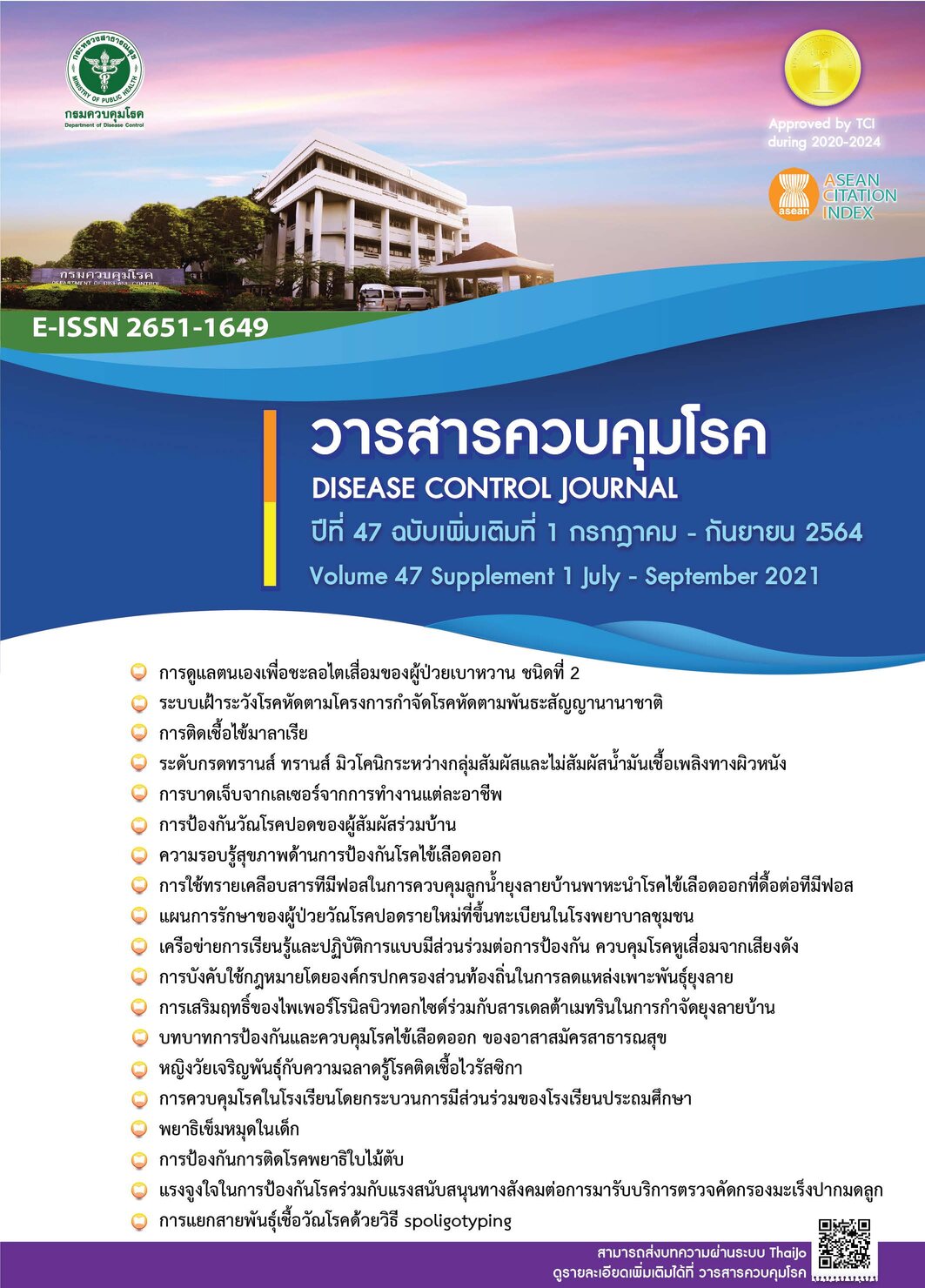Survey on prevalence of Enterobius vermicularis among children in Bang Nam Priao district, Chachoengsao province, Thailand
DOI:
https://doi.org/10.14456/dcj.2021.73Keywords:
prevalence, infection, Enterobius vermicularis, children, Bang Nam Priao district, Chachoengsao province, ThailandAbstract
This study aimed to investigate the prevalence of Enterobius vermicularis (E. vermicularis) among children in Bang Nam Priao district, Chachoengsao province. The relationship between E. vermicularis infection and related factors were analyzed as well as a comparison of the risk of E. vermicularis infection between boys and girls. Detection of E. vermicularis eggs by scotch tape technique among children aged 5-10 years in 6 schools in Bang Nam Priao district, Chachoengsao Province in September 2017. A total of 500 children were examined, most of them were girls (265). The overall prevalence of E. vermicularis was 3.40% (17/500) with 5.53% (13/235) in boys and 1.51% (4/265) in girls. The analysis between E. vermicularis infection and the factors of children (anal itching, nocturnal awakening) and parents (age, primitive background, socioeconomic status, prevention behavior of intestinal parasites) were not correlated with the E.vermicularis infection (p> 0.05). The results of an analysis to compare the risk of E. vermicularis infection between boys and girls revealed that boys were at higher risk of E. vermicularis infection than girls. (OR = 3.82; 95% CI =1.22-11.88 ; p=0.02). However, the results revealed that there is still an outbreak of E.vermicularis among children in Bang Nam Priao district, Chachoengsao province. Therefore, further investigation and treatment should be conducted and ways to prevent and control the spread of E. vermicularis in this area should be found.
Downloads
References
Norhayati M, Hayati MI, Oothuman P, Azizi O, Fatmah MS, Ismail G, et al. Enterobius vermicularis infection among children aged 1-8 years in a rural area in Malaysia. Southeast Asian J Trop Med Public Health. 1994;25:494-7.
Curtis AV, Danquah LO, Aunger RV. Planned, motivated and habitual hygiene behavior: an eleven country review. Health Educ Res. 2009;24(4):655-73.
Roberts LS, Schmidt GD, Janovy J. Foundation of parasitology. Boston, USA. McGraw-Hill Higher Education; 2009.
Lytvynets A, Langrova I, Lachout J, Vadlejch J. Detection of pinworm eggs in the dust of laboratory animals breeding facility, in the cages and on the hands of the technicians. Laboratory Animals. 2013;47:71-3.
Sangbari N, Dadban Shahamat Y, Abbasinejat Z, Sharbatkhori M, Rostami M. Survey of parasitic contamination of sewage sludges in northern Iran. J Appl Sci Environ Manage. 2018;22(8):1277-80.
Kucik CJ, Martin GL, Sortor BV. Common intestinal parasites. Am Fam Physician. 2004;69:1161-8.
Burkhart CN, Burkhart CG. Assessment of frequency, transmission, and genitourinary complications of enterobiasis (pinworms). Int J Dermatol. 2005;44:837-40.
Bøås H, Tapia G, Rasmussen T, Rønningen KS. Enterobius vermicularis and allergic conditions in Norwegian children. Epidemiol Infect. 2014;142(10):2114-20.
Pigac B, Masic S, Masic V. Enterobius vermicularis in the endometrium of the uterus: A case report. Iran J Parasitol. 2017;12(4):638-41.
Yong C, Tataryn I, Kowalewska-Grochowska KT, Balachandra B. Enterobius vermicularis infection of the fallopian tube in an infertile female. Pathol Res Pract. 2010;206(6):405-7.
Hong ST, Choi MH, Chai JY, Kim YT, Kim MK, Kim KR. A case of ovarian enterobiasis. Korean J Parasitology. 2002;40:149-51.
Nair GG, Balan P. Ovarian enterobiasis: a case report. Int J Res Med Sci. 2018;6(3):1055-7.
Bever PC, Kriz JJ, Lau TJ. Pulmonary nodule caused by Enterobius vermicularis. Am J Trop Med Hyg. 1973;22(6):711-3.
Arkoulis N, Zerbinis H, Simatos G, Nisiotis A. Enterobius vermicularis (pinworm) infection of the liver mimicking malignancy: presentation of a new case and review of current literature. Int J Surg Case Rep. 2012;3(1):6-9.
Fleming CA, Kearney DE, Moriarty P, Redmond HP, Andrews EJ. An evaluation of the relationship between Enterobius vermicularis infestation and acute appendicitis in a paediatric population—a retrospective cohort study. Int J Surg. 2015;18:154–8.
Choudhury S, Kumar B, Pal DK. Enterobius vermicularis infestation of urinary tract leading to recurrent urinary tract infection. Trop Parasitol. 2017;7(2):119–21.
Changsap B, Wannapinyosheep S, Nithikathkul C, Tangpong J. A Survey on enterobiasis along with potential risk factors among children in Khlong Toei Community, Bangkok and comparative study of the past. Journal of Helath Science. 2017;26(5):829-37.
Changsap B, Mongkolcharatchai K, Choosakul K, Teansuwang M, Komyan S, Nithikathkul C. The infection rate of Enterobius vermicularis among children in Bang Saothong district, Samutprakan province. Huachiew Chalermprakiet Sci Technol J. 2017;3(1):37-42.
Changsap B, Wannapinyosheep S, Tantravanich S, Plaikaew K, Saguansit P, Siridet R. Prevalence of pinworm (Enterobius vermicularis) infection among preschool and lower school children in Bangbo District, Samut Prakarn province, Thailand. Journal of Public Health. 2019;49(2):221-33.
Nithikathkul C, Changsap B, Wannapinyosheep S, Poister C, Boontan P.The prevalenceof enterobiasis in children attending mobile health clinic of Huachiew Chalermprakeit University. Southeast Asian J Trop Med Public Health. 2001;32(Suppl 2):138-42.
Graham CF. A Device for the diagnosis of Enterobius infection. Am J Trop Med. 1941;21:159-61.
Changsap B, Boontan P, Arnat N, Phoklin M, Ruangpattanatawee U, Chaitiamwong R, Jumrat K, Nithikathkul C. The prevalence of enterobiasis among children in Khlong Toei Community, Khlong Toei District, Bangkok. Songkla Med J. 2003;21(3):203-8.
Lee KJ, Lee IY, Im K. Enterobius vermicularis egg positive rate in a primary school in Chungchongnal-do (Province) in Korea. Korean J Parasitol. 2000;38(3):177-8.
Lee KJ, Ahn YK, Ryang YS. Enterobius vermicularis egg positive rates in a primary school in Gangwon-do (Province), Korea. Korean J Parasitol. 2001;39(4):327-8.
Downloads
Published
How to Cite
Issue
Section
License
Articles published in the Disease Control Journal are considered as academic work, research or analysis of the personal opinion of the authors, not the opinion of the Thailand Department of Disease Control or editorial team. The authors must be responsible for their articles.






